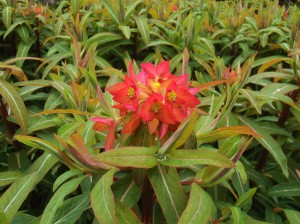Garden centres are fascinating places full of tempting plants and garden products but have you ever been and looked around the plants, then decided on a choice specimen because the label says it apparently has some amazing magic trick up it’s sleeve? This could be excellent flowering abilities, it may be a great ground-cover plant or be able to tolerate shade to some unbelievable degree. Most plants have their downsides as well as plus points too, but there are some plants that from experience (and client feedback too) that may not be the most excellent plants they seem to be even if the labels would tell us otherwise.
Some plants of course can be too ambitious with their plans to take over a garden. Some of the herbaceous border Euphorbias can be a bit too vigorous with their growth (!) and will readily leave the border and head out into the lawn or even invade other shrubs and plants. But of course not all Euphorbias spread and some are clump-forming like the large evergreen E.wulfenii, which can be a great and brilliant addition to the border.

A Euphorbia like this E.grifithii can look brilliant in a garden but can spread alarmingly!
There’s no denying that Elephants Ears or Bergenia cordifolia does look fantastic when young, glossy green leaves with red tinges, but give it a few years and it will look battered and tatty and it will sit in the garden looking rather forlorn and need splitting/replacing/digging up etc. Wouldn’t it have been much nicer perhaps to have something like a silver Lamium or two from day one that would brighten the border and flower away with little fuss.
It’s easy to see that not all plants in plant-families share the same bad traits. Just because one Euphorbia spreads rapidly doesn’t mean that they all do but it pays to tread wisely, do a little research and for us all not to believe the sales patter on the plant labels!
My favourite plant labels are those that describe a ground cover plant as being able to ‘cover 1m square in 3 years’. But once planted we easily discover that it admirably out-performs itself by covering half the border in year one and then makes it’s way into next doors garden in year two. Or Leylandii that will ‘grow to 3m in five years’, but we all know it will be 15m by year ten and so on. A little research is a wise thing.
There are plants that I would never advise planting. Carex pendula is an almost architectural grassy clump, it has seed heads too that look good in the breeze. It’s also got the great ability to self-seed everywhere, cracks in the paving, in amongst other plants and the borders, there will be mini-Carexs everywhere in a very short time. It’s best avoided.
Plants with thorns can be a maintenance problem but nevertheless can look good. Berberis thunbergii in either green, red or marbled coloured leaves do look nice but the thorns they leave in the borders can be a pain in the fingers on a regular basis. Gardening is never without it’s problems.
The maintenance of plants can be a good deciding factor when choosing plants, it’s not just the pruning or care of the plant but also consider if the plant will outgrow it’s allotted space and need replacing after a few years.
I have a friend who commented that they could write a book entitled ‘” I Planted One Of Those but I Rather Wish I Hadn’t’ and I think we could all perhaps find a suitable plant or two that we could contribute!



No comments yet.